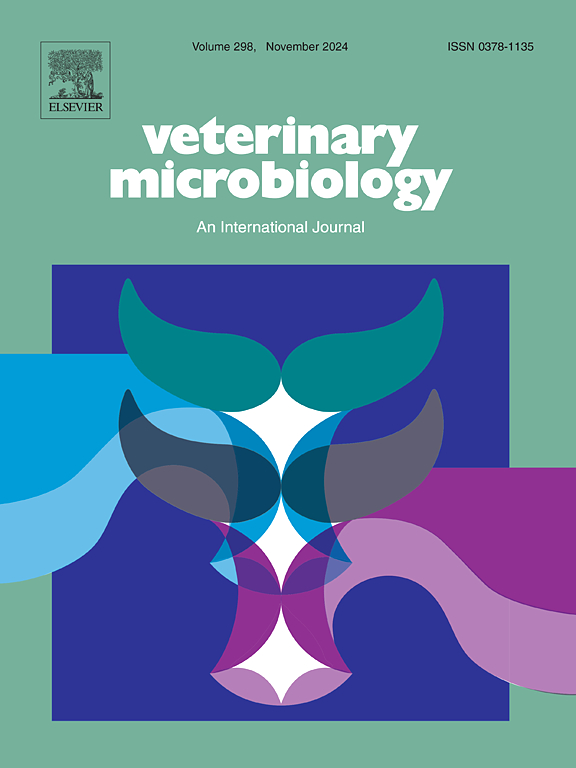多杀性巴氏杆菌不同宿主菌株毒力基因谱与其他遗传因素的相关性研究
IF 2.7
2区 农林科学
Q3 MICROBIOLOGY
引用次数: 0
摘要
多杀性巴氏杆菌具有很高的基因型变异性,这使得它能够在世界范围内引起各种各样的疾病,造成巨大的经济损失。本研究对66株 P.;从不同的宿主中分离出多杀菌株。通过纳入从NCBI数据库中选择的另外23株菌株,共分析了89株分离株的基因型特征。序列分析显示菌株荚膜血清群、LPS基因型、多宿主(MH)和农村工业研究与发展公司(RIRDC)多位点序列分型(MLST)。最常见的血清型是A:L3,其次是F:3和D:L6。10个毒力相关基因(film A, hgbA, hgbB, hsf-1, hsf-2, nanH, pfhA, ptfA, tadD, tbpA)的谱图将菌株划分为10个新的毒力基因谱(vgp),在之前描述的13个vgp的基础上,增加到23个vgp。一些菌株在tadD中存在多点突变,导致PCR过程中引物无法结合,导致假阴性结果。设计了新的引物来验证WGS的发现,并消除引物结合不匹配,提高未来的诊断准确性。菌株的ompA基因序列、MH和RIRDC STs与其VGP组存在相关性。还发现,tbpA仅存在于反刍动物源菌株中,菌株的其他基因型特征与毒力基因的出现之间存在进一步的相关性。本文章由计算机程序翻译,如有差异,请以英文原文为准。
Correlations between virulence gene profiles and other genetic factors of Pasteurella multocida strains isolated from various host species
Pasteurella multocida has a high genotypic variability, which allows it to cause a wide variety of diseases with huge economic losses worldwide. In this study, whole genome sequencing (WGS) of 66 P. multocida strains isolated from different host species was performed. By including an additional 23 strains selected from the NCBI database, genotypic characteristics of a total of 89 isolates were analysed. Sequence analysis revealed the strains' capsular serogroup, LPS genotype, multi-host (MH) and Rural Industries Research and Development Corporation (RIRDC) multilocus sequence typing (MLST). The most frequent serotype was A:L3, followed by F:3 and D:L6. The pattern of 10 virulence associated genes (fim A, hgbA, hgbB, hsf-1, hsf-2, nanH, pfhA, ptfA, tadD, tbpA) classified the strains into 10 new virulence gene profiles (VGPs), adding to the 13 VGPs described previously to provide a total of 23 VGPs. Some strains harboured multiple point mutations within tadD, that prevented primer binding during PCR, causing false negative results. New primers were designed to validate WGS findings and eliminate primer-binding mismatches, enhancing future diagnostic accuracy. A correlation was observed between the ompA gene sequences, MH and RIRDC STs of the strains and their VGP group. It was also observed that tbpA is only present in strains of ruminant origin, and further correlations were found between other genotypic characteristics of the strains and the occurrence of virulence genes.
求助全文
通过发布文献求助,成功后即可免费获取论文全文。
去求助
来源期刊

Veterinary microbiology
农林科学-兽医学
CiteScore
5.90
自引率
6.10%
发文量
221
审稿时长
52 days
期刊介绍:
Veterinary Microbiology is concerned with microbial (bacterial, fungal, viral) diseases of domesticated vertebrate animals (livestock, companion animals, fur-bearing animals, game, poultry, fish) that supply food, other useful products or companionship. In addition, Microbial diseases of wild animals living in captivity, or as members of the feral fauna will also be considered if the infections are of interest because of their interrelation with humans (zoonoses) and/or domestic animals. Studies of antimicrobial resistance are also included, provided that the results represent a substantial advance in knowledge. Authors are strongly encouraged to read - prior to submission - the Editorials (''Scope or cope'' and ''Scope or cope II'') published previously in the journal. The Editors reserve the right to suggest submission to another journal for those papers which they feel would be more appropriate for consideration by that journal.
Original research papers of high quality and novelty on aspects of control, host response, molecular biology, pathogenesis, prevention, and treatment of microbial diseases of animals are published. Papers dealing primarily with immunology, epidemiology, molecular biology and antiviral or microbial agents will only be considered if they demonstrate a clear impact on a disease. Papers focusing solely on diagnostic techniques (such as another PCR protocol or ELISA) will not be published - focus should be on a microorganism and not on a particular technique. Papers only reporting microbial sequences, transcriptomics data, or proteomics data will not be considered unless the results represent a substantial advance in knowledge.
Drug trial papers will be considered if they have general application or significance. Papers on the identification of microorganisms will also be considered, but detailed taxonomic studies do not fall within the scope of the journal. Case reports will not be published, unless they have general application or contain novel aspects. Papers of geographically limited interest, which repeat what had been established elsewhere will not be considered. The readership of the journal is global.
 求助内容:
求助内容: 应助结果提醒方式:
应助结果提醒方式:


